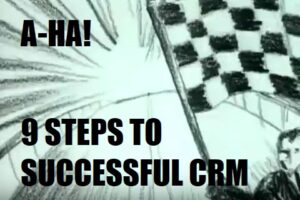 What does ‘a-ha’ mean to you? For me, it’s two things: (1) a great Norwegian soft rock band from the 1980s, and (2) an easy way to remember the 9 steps to successful CRM implementation. The steps form a cycle following the first 8 letters of the alphabet, ‘a-h’, then back to ‘a’ again:
What does ‘a-ha’ mean to you? For me, it’s two things: (1) a great Norwegian soft rock band from the 1980s, and (2) an easy way to remember the 9 steps to successful CRM implementation. The steps form a cycle following the first 8 letters of the alphabet, ‘a-h’, then back to ‘a’ again:
The 9 steps focus on the fact that a successful CRM implementation is a workforce transformation programme and not just a technology or IT project. So here are my 9 steps:
 Agreement.
Agreement.
Everyone needs to work toward the same goals. This might require time for your people to understand the nature of the transformation and why a new approach to CRM is even being considered in the first place. The more you have a culture of “It ain’t broke, why are you trying to fix it?” the more time you’ll need to reach an agreement.
Benefits. 
Software benefits are easy to establish from CRM. Things get to be easier, faster, better. Efficiencies will start to appear from improved workflows. But, in most cases, the point of a CRM transformation is to improve customer focus; to make it easier for people to do business with you. So KPIs and milestones should measure your CRM maturity at the outset, and along the way. Measurement may also include Voice of the Customer and Voice of the Workforce assessments. Now, benefits can be measured as tangible business outcomes.
Communication. 
Keep everyone in the loop. Assuming that messages will make their way around the workforce is not as effective as having a structured programme of messages that engage the whole team in the process and in your progress through the process. Successful CRM programmes often use the internal marketing team to orchestrate the communication initiative. This means taking them away from their customer-facing, business as usual jobs. It’s that important.
Deployment. 
Keep it simple; easy to use. Too many CRM deployments are over-complicated at the outset. This step in successful CRM is best achieved by delivering quick wins to the stakeholder community. Generate early recognition that the new CRM approach has something to offer. People will then be more willing to work with you and to make the business transformation more sophisticated and constantly evolving as your business world changes.
Education. 
Don’t expect people to understand what’s expected of them as things change. Build an education programme that explains the rationale behind the change. Share why the programme is in place, and not just the how to of doing some aspects of the job in new ways.
Feedback. 
The initial design of your CRM programme does not have a monopoly on success. Listen to the people who deal directly with your customers and learn from their feedback. Be prepared to make changes, to shift emphasis and to operate in an agile way to accommodate change. And make your feedback intentions part of the education process, so that people know that you will value their long term engagement in the transformation programme.
Governance. 
Make sure that all angles have been covered. Balance the interests of the shareholders, management, staff, customers, suppliers and, where appropriate, the wider community.
Holistic. 
Engage the whole business in your renewed customer focus. Not just the people who are directly involved in the programme and the new technology that you deploy. An example of how far you should take this comes from NASA in the 1960s. A workplace consultant stopped a janitor whilst he was sweeping a corridor. “What are you doing?” The janitor replied, “I’m helping put a man on the moon.” Now that’s what I call holistic!
So now we’ve travelled from A to H, ‘a-h’, and the nature of the transformation has morphed along the way and you’ve learned a few things that should have been included at the outset. So it’s time to set a new horizon and go back through the process. Go back to A, ‘a-ha’.
All this is not just academic. It comes from many years of working in successful CRM. So you can ‘Take on me’.




